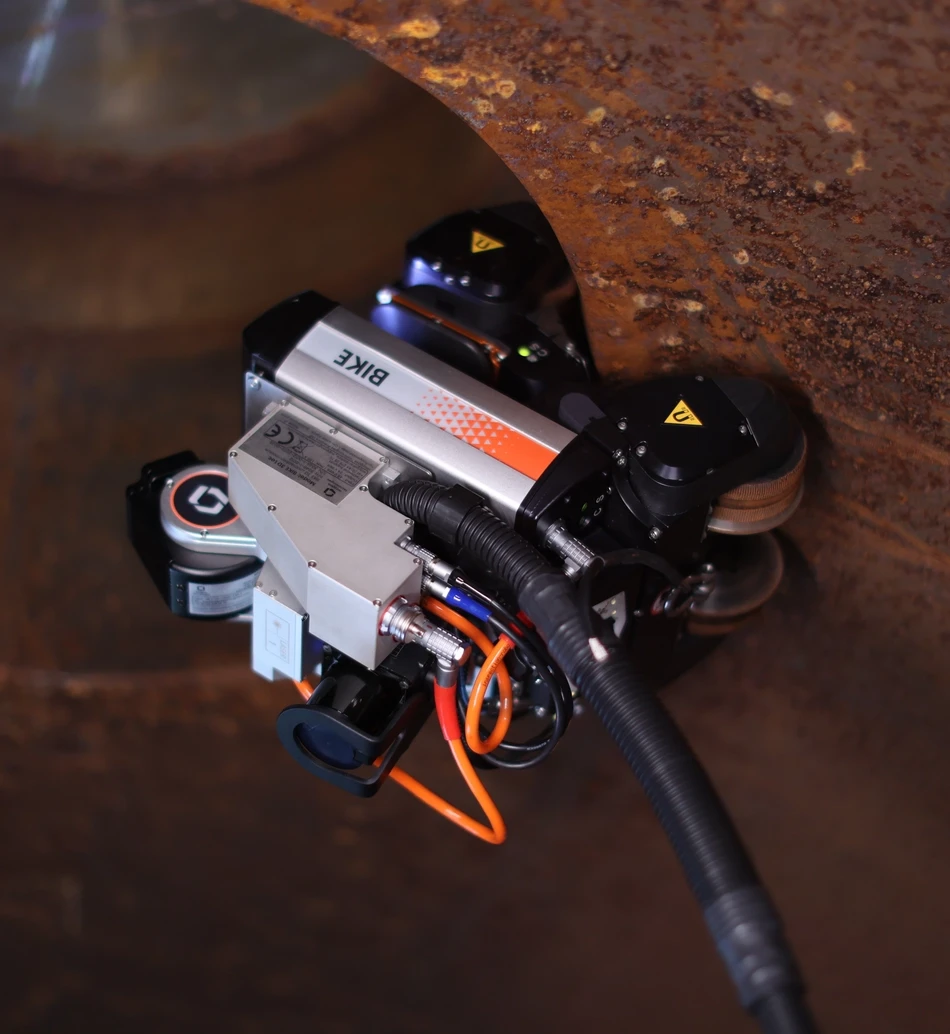Super magnetic inspector

Bike, a magnetic robot is capable of exploring large oil and gas facilities. Its uniqueness lies in a combination of agility and 3D localisation. A “Made in Switzerland” solution within the portfolio of US company Baker Hughes.
It is pitch dark, with only some distant metallic echoes to be heard. We are inside a pipeline of a gas power station, a labyrinth of criss-crossing pipes. Suddenly, there is a flash of light coming through a circular opening, followed by its source: a twenty-cubic-centimeter robot crawling down a chimney. It manoeuvres to enter the horizontal pipeline headfirst and moves forward whilst inspecting the site.
This amiable solitary robot isn’t called Wall-E, but Bike. Unlike Wall-E, it is a perfectly real solution proposed by Waygate Technologies, a leading business in industrial inspection and non-destructive testing (NDT) as well as a subsidiary of energy equipment giant Baker Hughes.
Bike was designed for hard-to-reach inspections that are inaccessible to humans, due to size constraints, verticality, or efficiency. Whenever human intervention would require emptying and cleaning up, scaffolding or alerting rescue teams, Bike can indeed save a lot of time and energy. All you need to do is carry it (10 to 15 kg depending on the configuration), place it at the end of a pipe, grab the remote control and start the inspection.
Bike takes contact measurements (impossible for drones), and its use is lighter than a “serpent” type inspection robot (a long-articulated arm requiring massive counterweight).
Such simplicity has convinced more than one: Waygate Technologies has sold about a hundred Bike robots since its first launch a few years ago. Its customers are energy and chemicals companies that wish to integrate it into their processes, inspection companies and site operators. Bike crawls through power plants, hydroelectric plants, and oil and gas facilities around the globe. It inspects gas turbines, pipes, pressure vessels, heat exchangers and even vessel hulls.
The robot’s impressive agility is based on its locomotion system, at the core of the concept initiated in 2009. The Swiss Federal Institute of Technology in Zurich and partners at that time worked together to create a magnetic inspection robot capable of negotiating inner and outer right-angled bends. It was an exciting technological challenge: how do you change directions at a right angle when super magnets “ stick ” the robot to the wall?
Working upside down ? No problem for this robot !
The first iteration included only two wheels, one behind the other (the name “ Bike ” is a reference to this initial choice). The extremely compact design made it possible for the robot to slip into very small-diameter pipes. It was useful for inspecting narrow pipes, but too unstable and weak for transporting the payload required for many missions. So, they moved on to a four-wheel version with a larger platform that still crawls ahead easily in 30 cm-diameter pipes (40 cm if it needs to manoeuvre).
Negotiating concave and convex angles requires a highly articulated locomotion system which Bike is fitted with. The two gears are inde- pendent, each can turn 90 degrees to the right or the left, with 30 degrees of gimbal (required for moving with agility over the pipes’ curved surface). And each wheel has its own ultraprecise engine, for separate speed control and appropriate allocation of steering forces.
The development process took several years and resulted in several patents. Bike was ready in 2016 and test-run by the first customers before being launched on the market in 2018. The project is just as sinuous as the robot’s paths. With mergers and acquisitions, the lead went to Baker Hughes, who consolidated their industrial inspec- tion activities in 2020 under a new entity, Waygate Technologies. However, development and production have continued to be “ Made in Switzerland ”.
The robotic platform was one thing, but it still had to be equipped for inspection missions.
Bike is laden with cameras. Those for navigation, in the front and back, equipped with fish-eye lenses and lighting, enable the oper- ator to guide the robot. And the inspection camera, thanks to its hinged support, can film in all directions, poke in a pipe or capture super close-ups. The robot also comprises a borescope – a long low-friction tube (10 m, even 30 m) that can be slid into the most confined spaces to film with a micro camera the hard-to-reach points (joints and welds, bends, nozzles).
Engineers have also developed an ultrasonic transducer. Placed between the front wheels of Bike, it measures and verifies pipe or pressure vessel wall thickness. It detects possible corrosion. Since ultrasound waves pass poorly through the air, the contact between the sensor and the wall is ensured by water from a neat outside pump.
Collected data is valuable, but even more so when geo-tagged with great precision. However, this poses another technical challenge, as Bike’s environment makes GPS usage impossible. Waygate Technologies had to design a unique localisation system, using a lidar that automatically retraces the robot’s path in a 3D environment. The operator always knows where it is. Every image captured, and every ultrasound thickness reading is precisely located, which makes subsequent intervention possible. Moreover, it makes it possible to repeat the same inspection, and so to measure the evolution of the situation.
Cameras, ultrasonic transducers, and a navigation system have become Bike’s standard equipment. Many customers are happy to use it for their inspections. Others purchase the naked platform and add their own components. Some others choose the optional modules offered by Waygate Technologies.
Among these, there are additional attachments for cameras and borescopes. Rubber-coated wheels to avoid scratching delicate walls (painted or coated). Additional magnetic wheels for carrying heavier payload. Longer umbilical cables for deeper inspection (the use of optical fibres, for very special applications only, enables the robot to venture up to 200 m).
If further customisation is required (a remote arm, other sensors, etc…). The business develops tailor-made solutions and provides engineering support to its customers.
Bike uses several LEMO solutions for power and signal transfer. Various versions of the robust K Series, designed for outdoor applications, connect for instance the umbilical cord, the control, and numerous external modules including the ultrasonic sensor, and the lidar. They were selected thanks to their renowned reliability and ease of use.
Some functionalities are way too specific to be part of Bike’s standard package (for instance, Waygate has created a version capable of descending 10 m underwater). However, the company strives to integrate what’s most useful for its customers. So, its robot keeps evolving and increasing its capabilities.
Currently, Waygate Technologies is in the process of working on a revolutionary functionality which will raise Bike to a higher level.
Which one ? - you may ask. Bike has just disappeared into a lateral pipeline and darkness is back again. We won’t learn anything more today.


